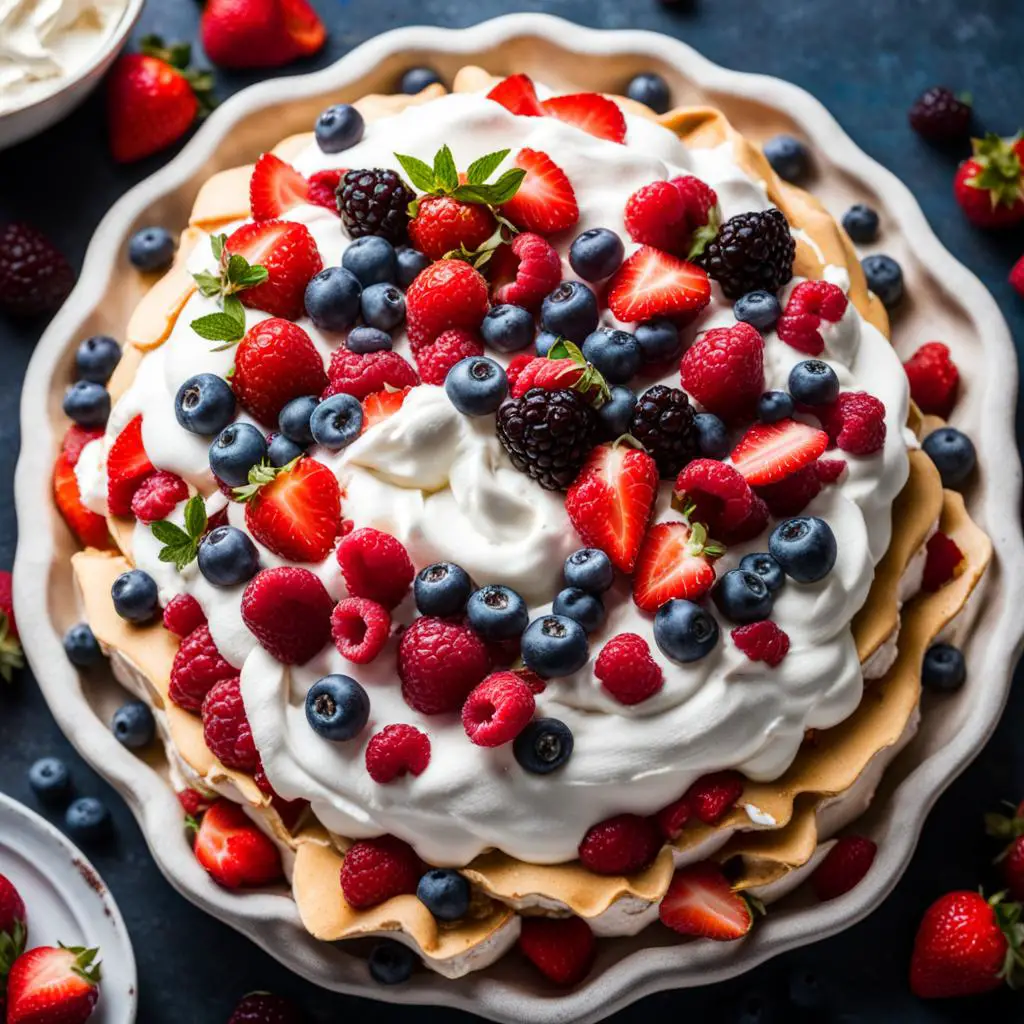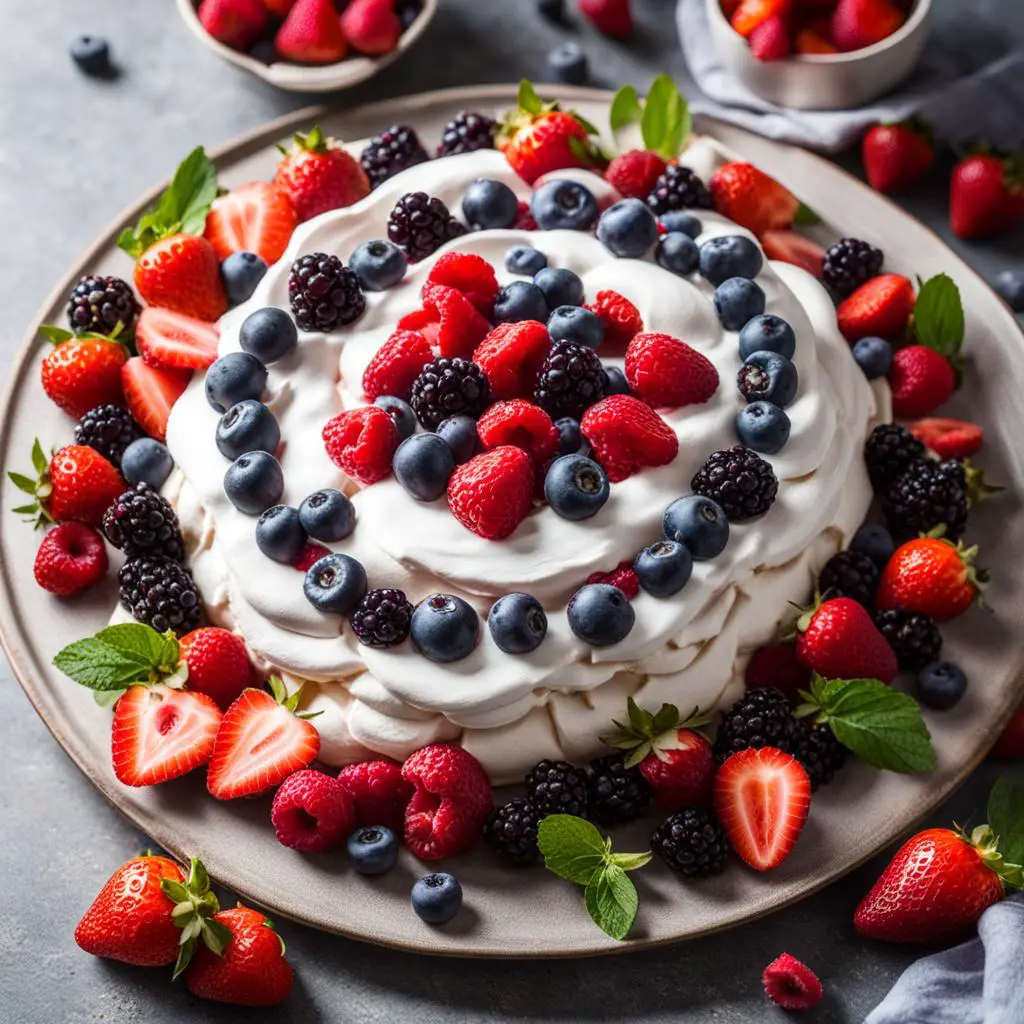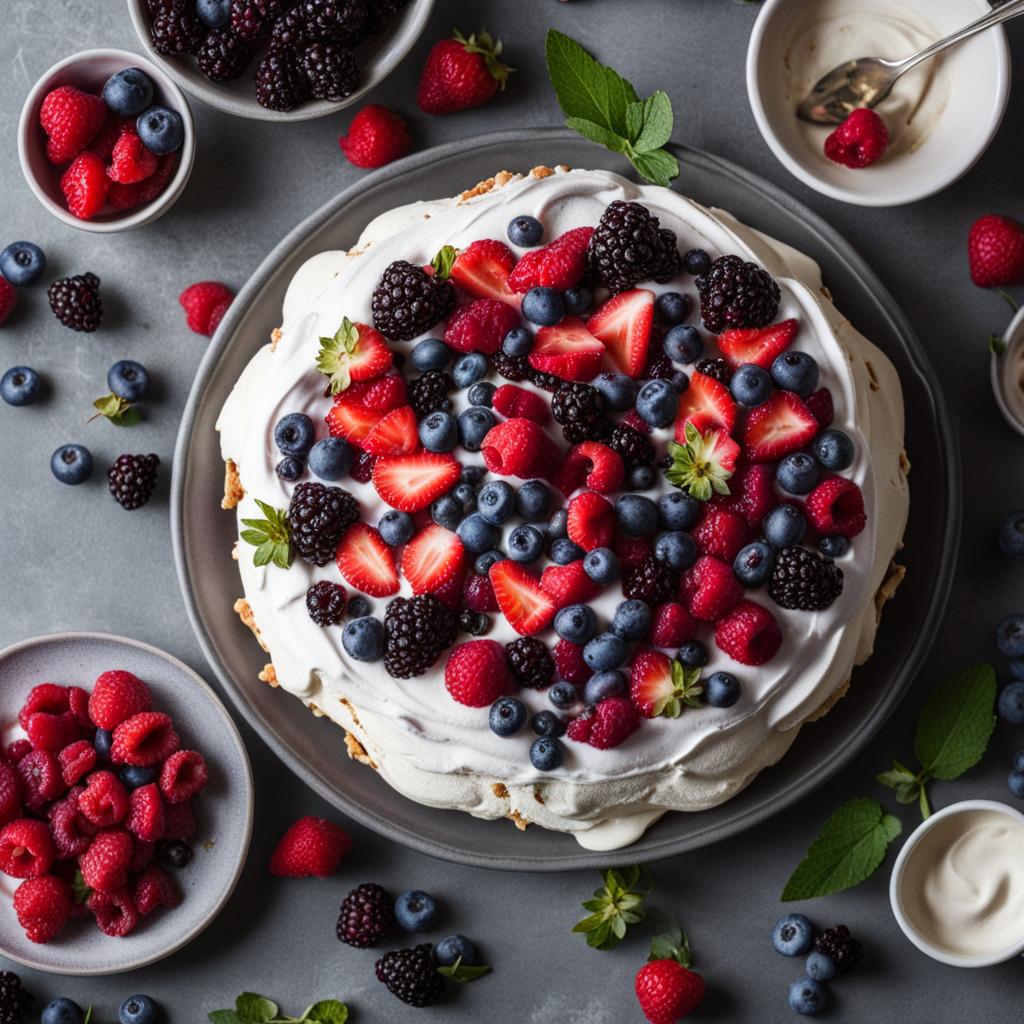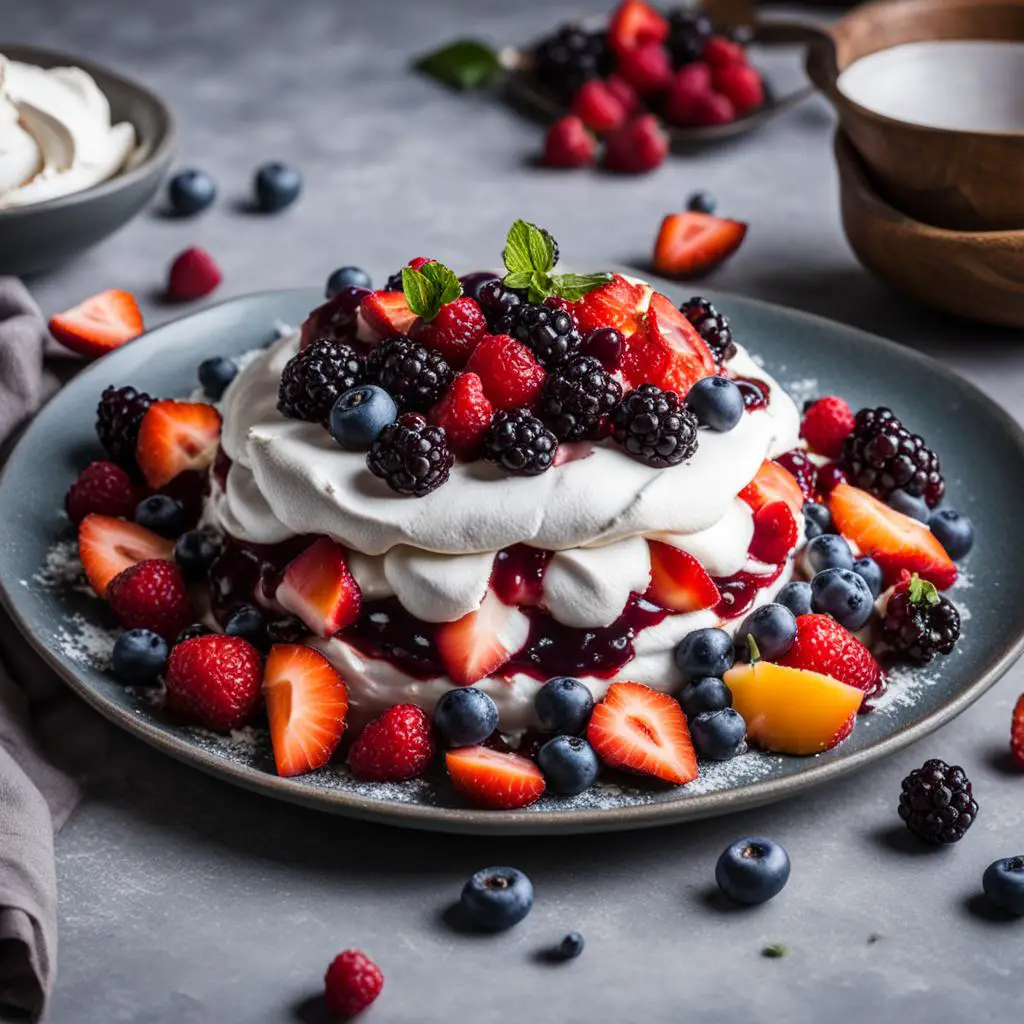Welcome to a world of indulgence and flavor with our irresistible berry pavlova recipe. This delectable dessert is perfect for vegans, offering a sweet, light, and crispy experience that will leave you wanting more. Made without eggs, our vegan pavlova is a true masterpiece of plant-based baking. So, gather your ingredients and let’s dive into the world of heavenly desserts!
Key Takeaways:
- Create a show-stopping berry pavlova with our vegan recipe.
- Utilize aquafaba, the liquid from cooked chickpeas, as an egg substitute.
- Whip aquafaba with cream of tartar and xanthan gum for a fluffy pavlova texture.
- Top your pavlova with vegan whipped cream and a medley of fresh berries.
- Store your pavlova properly for optimal texture and enjoyment.
How to Make Vegan Pavlova with Aquafaba

Creating a vegan pavlova with aquafaba is easier than you might think. Follow these simple steps to whip up a delicious dessert that’s sure to impress.
Reducing and Whisking Aquafaba
Start by reducing the aquafaba to concentrate the protein and remove excess water. This step is crucial for achieving the perfect texture in your pavlova. Once reduced, whisk the aquafaba with cream of tartar and xanthan gum until it becomes thick and frothy. The cream of tartar helps stabilize the aquafaba, while the xanthan gum provides structure. These two ingredients are key to creating a pavlova that holds its shape.
Adding Sweetness and Texture
Slowly add caster sugar to the whisked aquafaba and continue whisking until the mixture forms stiff peaks. This will give your pavlova a sweet taste and a light, airy texture. Once the mixture is ready, spoon half of it onto a lined baking tray in a circle shape. Then, use a piping bag to pipe the remaining mixture around the edges, adding extra texture and visual appeal.
Baking and Cooling
Bake your pavlova for two hours in a preheated oven. Avoid opening the oven door during baking to prevent the pavlova from deflating. After baking, let it cool completely in the oven. This step allows the pavlova to firm up and develop its signature crispy exterior.
With these easy steps, you’ll have a vegan pavlova with aquafaba that’s ready to be topped with your favorite berries and enjoyed by all!
Vegan Pavlova Topping Suggestions

When it comes to topping your vegan pavlova, the possibilities are endless. The combination of the sweet, crispy meringue and the creamy, tangy whipped cream provides the perfect canvas for a variety of delicious flavors. Here are some delightful topping suggestions to take your pavlova to the next level:
Fresh Berries:
What’s a pavlova without an abundance of fresh berries? Whether it’s juicy strawberries, plump blueberries, or tart raspberries, the vibrant colors and natural sweetness of the berries complement the pavlova beautifully. Use a mix of your favorite berries for a burst of flavor and a touch of elegance.
Exotic Tropical Fruits:
If you’re feeling adventurous, why not add a tropical twist to your pavlova? Slices of ripe mango, chunks of juicy pineapple, or the tangy sweetness of passion fruit can transport your taste buds to an island paradise. The tropical flavors pair wonderfully with the lightness of the pavlova, creating a refreshing and unforgettable dessert.
Crunchy Nuts:
For an added textural element, consider sprinkling some crunchy nuts on top of your pavlova. Chopped toasted almonds, crushed pistachios, or even a handful of caramelized pecans can provide a satisfying crunch that contrasts beautifully with the delicate meringue. This nutty addition adds depth of flavor and a hint of sophistication to your dessert.
| Topping | Description |
|---|---|
| Fresh Berries | A mix of juicy strawberries, blueberries, and raspberries for a burst of flavor. |
| Exotic Tropical Fruits | Slices of ripe mango, chunks of juicy pineapple, or the tangy sweetness of passion fruit for a tropical twist. |
| Crunchy Nuts | Chopped toasted almonds, crushed pistachios, or caramelized pecans for added texture and depth of flavor. |
Remember, the key to a divine vegan pavlova is to let your creativity shine. Don’t be afraid to mix and match flavors, textures, and colors to create a unique and memorable dessert. Whether you choose to go the classic route with berries or explore more unconventional options, your pavlova is sure to impress and delight.
Tips for Making the Perfect Vegan Pavlova

Creating the perfect vegan pavlova requires attention to detail and a few key tips. Follow these guidelines to ensure your pavlova turns out light, crispy, and delicious:
- Reduce the aquafaba: Concentrating the aquafaba by reducing it helps remove excess water and enhances the protein content. This is crucial for giving the pavlova structure and preventing it from deflating or becoming watery.
- Use stabilizers: Cream of tartar and xanthan gum are excellent stabilizers that help maintain the shape and texture of the whipped aquafaba. They provide the necessary structure for a successful pavlova.
- Be patient while whisking: Whisk the aquafaba, cream of tartar, and xanthan gum until they reach stiff peaks. This will take some time, so be patient and avoid rushing the process. The pavlova’s texture relies on achieving the right consistency.
- Avoid opening the oven door: Once the pavlova is in the oven, resist the temptation to open the door and check on it. Sudden temperature changes can cause the pavlova to collapse or crack. Trust the process and let it bake undisturbed.
By following these tips, you’ll be on your way to creating the perfect vegan pavlova. Experiment with different flavors and toppings to personalize your dessert and impress your guests with a stunning plant-based treat.
Table: Aquafaba Concentration Times
| Aquafaba Amount | Reduction Time |
|---|---|
| 1 cup | 15 minutes |
| 2 cups | 25 minutes |
| 3 cups | 35 minutes |
Achieving the perfect vegan pavlova requires patience and attention to detail. By reducing the aquafaba, using stabilizers, whisking to stiff peaks, and avoiding opening the oven door, you’ll be well on your way to a stunning and delicious dessert.
Serving and Storing Vegan Pavlova
Once you’ve assembled your delicious vegan pavlova, it’s important to know how to serve and store it properly to maintain its texture and flavor. Follow these tips to ensure your pavlova stays fresh and delicious:
Serving:
For the best texture and taste, it’s recommended to serve your vegan pavlova immediately after assembly. The crispy meringue and fluffy center are at their prime when freshly made. The contrast of the sweet and tart flavors is truly delightful.
If you need to serve the pavlova later, it’s best to keep the cream separate from the meringue layers. Store the cream in the fridge, and keep the meringue layers at room temperature in an airtight container. This will prevent the meringue from becoming soggy.
When ready to serve, simply add the whipped cream to the meringue layers and top with your choice of fresh fruits. The combination of creamy, tangy, and sweet flavors will create a dessert that is sure to impress.
Storing:
If you have leftovers or need to store a fully assembled pavlova, it’s best to store it in the fridge. The cream may soften slightly, but it will still taste delicious. Keep in mind that the meringue may become slightly softer over time, but it should still retain its overall texture.
It’s important to note that the pavlova is best consumed within 12 hours of assembly for optimal taste and texture. After this time, the meringue may start to lose its crispness.
Table: Tips for Serving and Storing Vegan Pavlova
| Tips for Serving | Tips for Storing |
|---|---|
| Serve immediately after assembly for best texture. | Store fully assembled pavlova in the fridge. |
| Keep cream separate if serving later. | The cream may soften slightly in the fridge. |
| Add whipped cream and fresh fruits just before serving. | Consume within 12 hours for optimal taste and texture. |
Can I Substitute Papaya for Berries in the Vegan Berry Pavlova Recipe?
When making a vegan berry pavlova, it’s best to stick to berries for the desired taste and texture. While papaya can be a delicious addition to many dishes, using it as a substitute might alter the overall flavor profile. However, if you’re looking to incorporate papaya into your vegan dessert repertoire, why not try a flavorful papaya smoothie bowl recipe instead?
Conclusion
Well, you’ve made it to the end of our berry pavlova journey! Now armed with a delicious pavlova recipe, you can whip up this delectable berry dessert anytime your sweet tooth starts calling. Whether you’re a vegan or simply looking to explore plant-based desserts, this pavlova is sure to impress.
The secret to this vegan pavlova lies in the magical aquafaba. By reducing it and combining it with cream of tartar and xanthan gum, you can achieve a light and fluffy pavlova with a crispy exterior. It’s like biting into a marshmallow cloud!
Once your pavlova is baked to perfection, it’s time to get creative with your toppings. Spread on some vegan whipped cream (think coconut or your favorite dairy-free alternative) and pile on a mix of juicy berries like raspberries, blackberries, and cranberries. The burst of fruity flavors will complement the sweetness of the pavlova beautifully.
So go ahead, give this berry pavlova a try and let your taste buds go wild. With a little practice, you’ll be a pavlova pro in no time. Who knows, maybe you’ll even start your own pavlova revolution, one fluffy meringue at a time!
FAQ
What is aquafaba and why is it used in vegan pavlova?
Aquafaba is the leftover liquid from cooked chickpeas. It is used in vegan pavlova as a substitute for eggs. When whipped, it creates a fluffy and marshmallow-like texture, making it perfect for vegan desserts.
How do I reduce aquafaba?
To reduce aquafaba, you can simmer it on the stove over low heat until it thickens and reduces in volume. This process helps concentrate the protein and remove excess water, which is important for the pavlova to hold its shape.
What can I use as a substitute for cream of tartar and xanthan gum?
Cream of tartar and xanthan gum are used to stabilize the whipped aquafaba and give the pavlova structure. If you don’t have these ingredients, you can try using lemon juice or vinegar as a substitute for cream of tartar, and agar agar or cornstarch as a substitute for xanthan gum. However, the results may vary.
Can I make vegan pavlova ahead of time?
While it’s best to serve the pavlova immediately after assembly for the best texture, you can make it ahead of time. Keep the cream separate in the fridge and the meringue layers at room temperature in an airtight container. Once the cream is added, store the pavlova in the fridge for up to 12 hours.
How long can I store vegan pavlova?
The pavlova can be stored without any toppings for up to 2 days. However, for the best taste and texture, it’s recommended to consume it within the first day. As the pavlova absorbs moisture from the toppings, it may start to soften over time.
Can I use other fruits as toppings for vegan pavlova?
Absolutely! While berries are a classic choice for pavlova, you can get creative and experiment with different fruits. Try using sliced kiwi, passion fruit, mango, or any other fruit of your liking to add color and flavor to your pavlova.
Welcome to VeganClue - My name is Robert Van De Ville and together with my team we spent hundreds of hours researching the most relevant topics for Vegans and non yet Vegans. Are you looking for more information about Veganism, animal welfare, diet, health, and environmental benefits of the Vegan lifestyle? You are in the right place! Enjoy the site.


